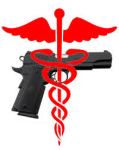You may recall that last year eight national medical organizations plus the American Bar Association issued a manifesto calling for medical professionals to become more involved in the debate about gun violence. Actually there wouldn’t be any reason for physicians to justify or explain their professional responsibility to counsel patients on gun violence if it weren’t for red-meat politicians at the state and federal level who gin up political support from Tea Party elements by pretending that guns aren’t a risk to health.
 Of course we all know that guns don’t kill people, right? Know how many gun homicides and suicides were recorded by the CDC in 2014? 32,743. Know how many homicide-suicide deaths occurred with every other type of device? 26,354. Nah, guns aren’t lethal, people are lethal. And if you really agree with Wayne-o and all the other gun promoters on that one, please don’t waste your time sending me a snarky tweet or a nasty blog. Go lay brick.
Of course we all know that guns don’t kill people, right? Know how many gun homicides and suicides were recorded by the CDC in 2014? 32,743. Know how many homicide-suicide deaths occurred with every other type of device? 26,354. Nah, guns aren’t lethal, people are lethal. And if you really agree with Wayne-o and all the other gun promoters on that one, please don’t waste your time sending me a snarky tweet or a nasty blog. Go lay brick.
When the Florida gun-crazies passed the physician gag law I was actually somewhat pleased in a perverse kind of way. Because the truth is that prior to Docs v. Glocks, medicine had allowed itself to get sidelined on the gun issue through a combination of inadvertence, lack of specific counseling guidelines and the refusal of the federal government to fund gun-violence research through the CDC. And even though medical academies like the AAP had issued pronouncements about gun violence over the years, stating a concern about a medical problem is one thing, doing something about it is something else.
But last year’s manifesto by the 8 medical organizations marked a turning of the tide, and a recent editorial in the Boston Globe demonstrates that the medical community is moving back into the center of the gun debate where it happens to belong. The editorial, “Doctors should talk to patients about guns,” is a no-holds barred declaration by the newspaper’s editors that doctors need to go beyond voluntary screening for gun risk and incorporate such questions into their everyday contact with patients. The editorial recommends the development of clinical guidelines that would not only give guidance for what kinds of questions should be asked, but would “lay the groundwork for breakthrough research on the effect of gun ownership and the roots of gun violence.” In this regard, doctors in Massachusetts have a willing and forceful ally in State Attorney General Maura Healey, who has offered the resources of her office to help develop and implement treatment guidelines as well.
The Globe editorial was acknowledged several days later in a Letter to the Editor from two prominent Massachusetts pediatricians, Judith and Sean Palfrey, the former a past-President of the AAP, the latter a leader in the campaign to rid lead from environments in which children live and play. What makes this letter so important is the following statement: “Guns, and the bullets they shoot, are deadly pathogens….”
Like it or not, that statement happens to be the truth. The evidence to bolster that statement has been published again, and again, and again. And I believe that as physicians get more involved in counseling their patients about guns, their approach should be governed by this one fact above all: guns are pathogens. And a pathogen is something which causes a disease. And 120,000 violent deaths and injuries each year is a disease. Period. Let’s cut the nonsense, okay?
By the way, calling a gun a pathogen has nothing to do with 2nd-Amendment ‘rights.’ I happen to be carrying around 30 pounds of excess weight. And when I see my beloved internist he would be remiss if he didn’t tell me to cut out some of those carbs that I love to eat. But it’s my choice if I want to keep eating more than I should. And it’s his responsibility to remind me of how what I choose to eat might affect my health. Think it’s different with guns? Think again.
Leave a Reply